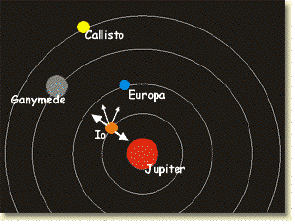The Composition and Properties of the Galilean Moons
The Galilean moons mimic a small solar system and we see a natural variation of planetary conditions as one moves further from Jupiter, like the Sun's planets. Mercury, near to the Sun, is well heated (on the daytime side), and as you move further from the Sun, planets get cooler. The same is true for the Galilean moons, which are 'warmer` near Jupiter. But the heat is not radiant energy, but instead due to tidal heating. As one moves in to out, from Io out to Callisto, we see a steady drop in the density of the moons. Also, note, the period of each of the moons are exactly 2x (or 1/2) the moon next to it. This is called orbital resonance.
| Density | Distance | Orb Period | Io | 3.55 g/cc | 421,000 km | 1.75 days | Europa | 3.01 g/cc | 671,000 km | 3.55 days | Ganymede | 1.93 g/cc | 1070,000 km | 7.12 days | Callisto | 1.83 g/cc | 1883,000 km | 17 days |
Io's density is similar to the Moon, and probably has a similar composition to the Moon: silicate rocks, very little (if any) iron, and very little (if any) water ice.
Europa shows a slightly lower density, indicating a substantial fraction of water ice is present. Perhaps 10-15% of Europa may be water ice.
Ganymede & Callisto show a very low density, requiring that both these moons are made up of roughly half ice.
 The importance of Tidal Heating on Io and Europa
The importance of Tidal Heating on Io and Europa
No one would have
expected a geologically active planet (or moon)
as small as Io! Moreover, tidal heating of Europa,
which has a significant fraction of water on it, means
liquid oceans of water are capable of existing at
these extreme distances from the Sun.
The tug that Io feels from the outer moons cause the distance between Io and Jupiter to vary. Io's slightly elliptical orbit subjects Io to tremendous tidal forces that alternately squeeze and stretch its interior. This perpetual friction generates enormous amounts of heat and pressure within Io, causing molten material and gases to rise through fractures in the crust and to erupt onto the surface. Io's tidal heating is 200 more effective than the radioactive heating on Earth!
Europa is only slightly effected by this tidal war between Jupiter and its largest moons. The effect of tidal heating is not so great on Europa because it is further from Jupiter. The gravitational variation over the slightly elliptical orbit of Europa is not so great at such large distances from Jupiter. Gravity has an inverse square law, just like light. A certain change in distance, say 10 km, means less in variation in gravitational pull at 10 million km than it does at 100 km. (Again, think of the variation in light intensity with these relative distances.)